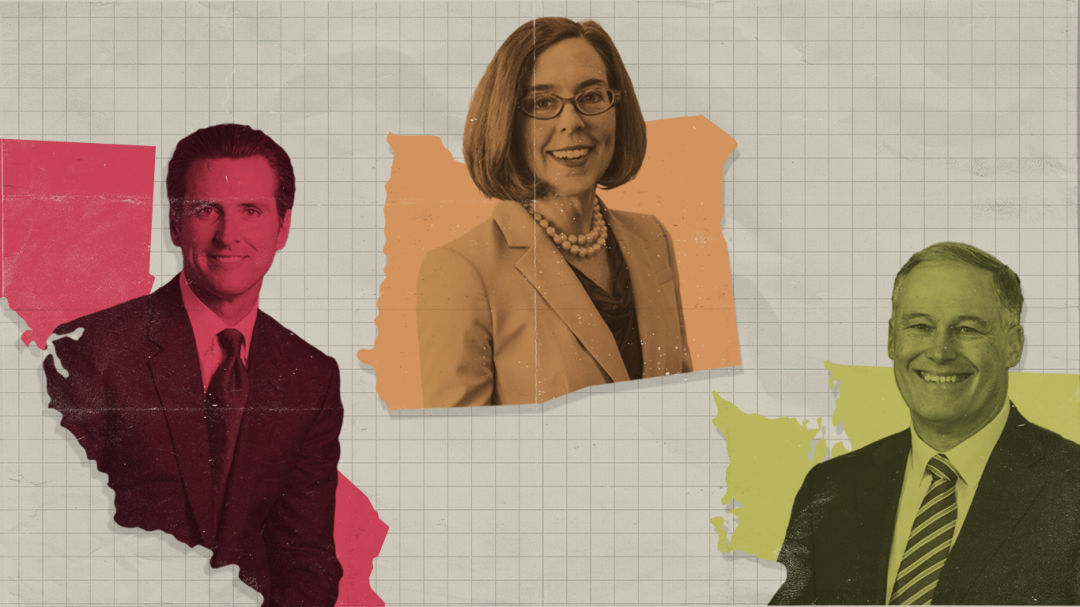Comparing Lockdown Levels in the West Coast States

Governors Jay Inslee, Kate Brown, and Gavin Newsom have taken slightly different approaches to rising COVID cases in the West
Image: Brian Breneman
In rainy, chilly Oregon, we’re calling it a freeze. In California, where cars reign supreme, it’s pulling the emergency brake. And in no-nonsense Washington, there’s no catchphrase, just new restrictions coming down the pike.
Either way, given the terrifying spike in positive COVID cases in the region—and on the heels of all three states urging residents to curb non-essential inter-state travel during the holiday season—the West Coast governors have issued strict new orders aimed at keeping hospitals from becoming overrun in the coming days.
Given that, what better time to dust off the handy risk-assessment tool we at Portland Monthly first put together in the spring, a quick color-coded shorthand to know whether the people you meet are, say, paying attention to scientists and doctors or are elected officials who publicly airing their plans to host come one, come all Thanksgiving feasts, masks optional.
(If you’re listening to Dr. Fauci, Dr. Esther Choo, and company, you’re likely in the cautious red-orange-yellow group right now—if you’re incoming Clackamas County Commission Chair Tootie Smith, you’re devil-may-care icky beige.)
But why stop there? Let’s review the new rules in Oregon, Washington and California, and then try to pinpoint where each state lies on our risk assessment matrix. To the data!
Length of Time for the Freeze/Emergency Brake/Restrictions
(Subject to change, because as Gov. Kate Brown is fond of saying, the virus makes the timeline)
Washington: Four weeks, statewide.
Oregon: Two weeks in some counties, four weeks in others.
California: Indefinite, and more restrictions could arrive by the end of this week.
Verdict: Red for California, Orange for Washington, Orange/Yellow for Oregon, depending on where you live.
Masks
Washington: Face coverings required in public spaces and shared spaces, both indoors and outdoors.
Oregon: Masks or face coverings required statewide in indoor public spaces and outdoors when six feet of distance can’t be maintained.
California: Face covering always required when outside the home, with few exceptions, including being alone in a car, or outdoors and six feet from anyone except those in your household, or at work but by yourself.
Verdict: Red-orange for all. This stops short of all-masks-all-the-time outdoors, regardless of whether anyone else is in ear or eyeshot. But all three policies are quite similar, and light years ahead of other states where governors have declined to institute statewide mask mandates. (Looking at you, Missouri.)
Restaurants
Washington: Outdoor dining service, no indoor dining allowed.
Oregon: Take-out and delivery only (and under serious pressure to consider allowing to-go cocktails).
California: Outdoor dining service only across the bulk of the state.
Verdict: Red for Oregon, Orange for California and Washington. Should be interesting to see if Brown sticks with the ban on outdoor dining after four weeks is up.
Get-togethers at home
Washington: No indoor gatherings at all, unless visitors have quarantined for a week and can show a negative COVID test. But you are allowed to get together outside, with no more than five people who are not from your household.
Oregon: Indoors and outdoors alike, you are not supposed to be with more than six people total from more than two households. (That’s yours and one other one.)
California: Outdoors only, a maximum of three households.
Verdict: Red level for Oregon, Red-orange for California, and Washington. Lots of variation here, incidentally—if you think it's confusing, join the club.
Religious services
Washington: Indoor attendance limited to 25 percent of capacity with a maximum of 200 people.
Oregon: Indoor attendance limited to 25 people; outdoor attendance can be 50 people.
California: Outdoors only.
Verdict: Red for California, Orange for Oregon, and Yellow (verging on Green) for Washington. Two-hundred people? Indoors? Eek.
Retail stores
Washington: Open, but occupancy limits are set at 25 percent of usual. (In the Evergreen state, this includes grocery stores and malls, in case you were thinking of hitting up the Vancouver Mall this weekend. Know before you go!)
Oregon: Open, but with restrictions. At grocery stores, occupancy limits are at 75 percent of capacity.
California: Open, but a maximum 25 percent capacity in most retail stores, and food courts and common areas in malls are closed.
Verdict: Orange in California and Washington, Yellow in Oregon.
Fitness studios and gyms
Washington: Closed
Oregon: Closed
California: Outdoors only
Verdict: Red for Oregon and Washington, Yellow for California—but keeping fit outdoors is easier when the weather forecast isn’t 46 degrees and raining from now until mid-April.
Enforcement
Washington: Limited, with Inslee telling the Seattle Times that state troopers are unlikely to arrive at people’s doors on Thanksgiving to break up gatherings.
Oregon: Brown has said she will work with state police and local law enforcement to mandate compliance with the freeze.
California: Unclear, but Gov. Gavin Newsom has been floating the idea of a curfew in the coming days if cases consider their alarming rise.
Verdict: Red for Oregon, Yellow for Washington and maybe burnt sienna for California, if they follow through with that curfew.
So, which state is the strictest as we enter the holiday season? It’s hard to say, as each governor seems to have slightly different metrics and priorities. This is where a single national standard would really come in handy—paging President-Elect Joe Biden, stat.
Meanwhile, if you want to do some more compare and contrasting, California’s full standards are here, Washington’s are outlined here, and Oregon’s are here.




